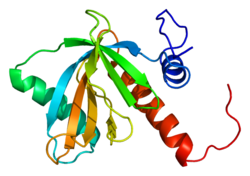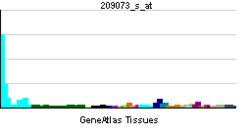Protein numb homolog is a protein that in humans is encoded by the NUMB gene. The protein encoded by this gene plays a role in the determination of cell fates during development. The encoded protein, whose degradation is induced in a proteasome-dependent manner by MDM2, is a membrane-bound protein that has been shown to associate with EPS15, LNX1, and NOTCH1. Four transcript variants encoding different isoforms have been found for this gene.[5]
The protein Numb is coded for by the gene, NUMB, whose mechanism appears to be evolutionarily conserved.[6] Numb has been extensively studied in both invertebrates and mammals, though its function is best understood in Drosophila. Numb plays a crucial role in asymmetrical cell division during development, allowing for differential cell fate specification in the central and peripheral nervous systems. During neurogenesis, Numb localizes to one side of the mother cell such that it is distributed selectively to one daughter cell. This asymmetric division allows a daughter cell containing Numb to acquire a different fate than the other daughter cell.
- ^ a b c GRCh38: Ensembl release 89: ENSG00000133961 – Ensembl, May 2017
- ^ a b c GRCm38: Ensembl release 89: ENSMUSG00000021224 – Ensembl, May 2017
- ^ "Human PubMed Reference:". National Center for Biotechnology Information, U.S. National Library of Medicine.
- ^ "Mouse PubMed Reference:". National Center for Biotechnology Information, U.S. National Library of Medicine.
- ^ "Entrez Gene: NUMB numb homolog (Drosophila)".
- ^ Pece S, Confalonieri S, R Romano P, Di Fiore PP (January 2011). "NUMB-ing down cancer by more than just a NOTCH". Biochim. Biophys. Acta. 1815 (1): 26–43. doi:10.1016/j.bbcan.2010.10.001. PMID 20940030.






